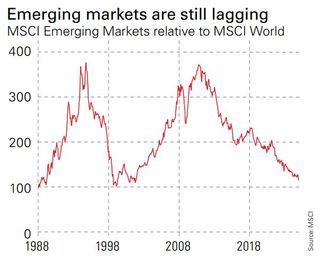I am a longstanding bull on emerging markets – a position that feels more difficult with every passing year of disappointing returns. Emerging markets have lagged developed ones for more than a decade: 3.7% per year over 10 years, versus 9.1% for the MSCI World and 4.7% for the MSCI World ex USA. Still, we can at least say that 2024 has been a bit underwhelming rather than awful.
The MSCI Emerging Markets index is up by 13% so far this year (12% in sterling terms), which sounds reasonable until we note that the MSCI World is up by 22%. The exceptional performance of America plays a large role in this, and emerging markets have actually beaten the MSCI World ex USA (up 11%), but it’s difficult to claim that’s enough reward for the extra risk. Still, emerging markets are a very diverse group and some have done very well.

(Image credit: MSCI)
Winners and losers in emerging markets
India has returned 19%, despite recent signs of nerves, and China is up by about the same after a sharp rally in September driven by hopes that government policy is turning more pro-growth.
Sign up to Money Morning
Don’t miss the latest investment and personal finances news, market analysis, plus money-saving tips with our free twice-daily newsletter
Don’t miss the latest investment and personal finances news, market analysis, plus money-saving tips with our free twice-daily newsletter
Taiwan is up by 41%, although that’s due to one stock – chipmaker TSMC, which accounts for half the index and rose 75%. Almost anybody who bought a Taiwan fund on the basis that the economy is heavily geared to the tech boom would have done worse than this since most funds have to cap their exposure to a single stock.
Of course, Taiwan is an emerging market only in an investment sense (there are certain technical restrictions on market access): in reality, it is a highly developed country, as is South Korea, which had a poor year (down 12.5%, and 21% in sterling terms) even before the president tried to declare martial law recently. This is also partly due to one stock: Samsung Electronics, a quarter of the index, which has slumped 30% amid problems with its own chip-making business.
These are the four key markets, together amounting to 75% of the index. Elsewhere, Brazil struggled with rising interest rates and concerns about government spending, leaving the market down 11% (and more than twice that in sterling terms due to the slump in the real). Mexico has fallen a similar amount on concerns that a landslide victory for the governing party may undermine the rule of law. Middle East markets have suffered from weaker oil prices.
Southeast Asia has been lacklustre, even though Singapore (which is part of the developed index, but economically geared to its neighbours) is up 32%. A single stock again accounts for part of that – internet group Sea, headquartered in Singapore but listed in New York, rallied 200%.
The good news is that emerging markets still look cheap, both in aggregate (a forecast price/earnings ratio of 12) and individually – except India and perhaps Taiwan. What’s missing are tailwinds to lift more markets at the same time. History suggests a weak dollar would be helpful, but we’re certainly not seeing that at the moment. Still, if US stocks overheat, emerging markets are the obvious contrarian value play.
This article was first published in MoneyWeek’s magazine. Enjoy exclusive early access to news, opinion and analysis from our team of financial experts with a MoneyWeek subscription.
